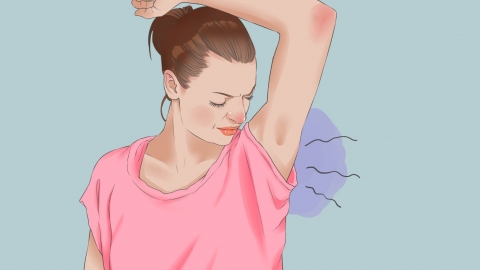What should I do if I have body odor (bromhidrosis)?
Generally, axillary bromhidrosis may be caused by genetic factors, hormonal fluctuations during puberty, secondary infection of axillary eczema, axillary fungal infection, or axillary apocrine gland inflammation. It is recommended to seek timely medical consultation to identify the underlying cause and improve the condition under a doctor's guidance through general treatments, medications, etc. A detailed explanation is as follows:

1. Genetic factors: A family history of axillary bromhidrosis can lead to abnormal structure of the axillary apocrine glands in individuals, resulting in sweat containing more organic substances. Bacterial breakdown of sweat produces odor. Daily care includes washing the armpits daily with warm water, drying thoroughly afterward, applying antiperspirants to reduce sweat secretion, and wearing loose, breathable cotton clothing.
2. Hormonal fluctuations during puberty: Rising androgen levels during puberty stimulate the development and maturation of axillary apocrine glands, increasing sweat production. Bacterial breakdown of sweat leads to odor, commonly seen in individuals aged 12–25 years. Patients should reduce strenuous exercise and promptly shower and change clothes after physical activity.
3. Secondary infection of axillary eczema: Prolonged dampness or allergen exposure in the armpit can trigger eczema, damaging the skin barrier and making it susceptible to bacterial invasion and secondary infection. The infection worsens odor through bacterial breakdown of sweat, accompanied by erythema, papules, and itching in the axillary skin. Patients should follow medical advice to use medications such as desonide cream, mupirocin ointment, and loratadine tablets.
4. Axillary fungal infection: Warm, moist environments in the armpits are conducive to fungal growth, such as Candida. Fungal proliferation breaks down skin surface substances and sweat, producing a distinct odor, accompanied by flaking and annular erythema on the skin of the armpit. Patients should follow medical advice to use antifungal medications such as ketoconazole cream, terbinafine cream, and itraconazole capsules.
5. Axillary apocrine gland inflammation: Blockage of axillary apocrine gland ducts prevents proper drainage of secretions, causing chronic inflammation. Inflammatory stimulation leads to abnormal secretions that mix with sweat and produce a strong odor; severe cases may develop abscesses and sinus tracts. Patients should follow medical advice to use medications such as cefaclor capsules, metronidazole tablets, and clindamycin gel to control inflammation.
Routinely, patients should avoid frequent shaving of underarm hair to prevent skin damage and subsequent infection. Additionally, maintaining regular sleep patterns, avoiding late nights, and reducing endocrine disturbances can help manage sweat gland secretion, alleviating symptoms of axillary bromhidrosis through comprehensive care.






